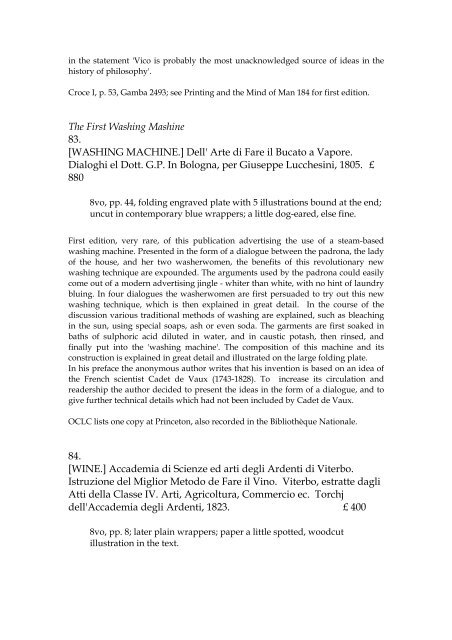«Merge Record #»«Title» - Schulz-Falster Rare Books
«Merge Record #»«Title» - Schulz-Falster Rare Books
«Merge Record #»«Title» - Schulz-Falster Rare Books
You also want an ePaper? Increase the reach of your titles
YUMPU automatically turns print PDFs into web optimized ePapers that Google loves.
in the statement 'Vico is probably the most unacknowledged source of ideas in the<br />
history of philosophy'.<br />
Croce I, p. 53, Gamba 2493; see Printing and the Mind of Man 184 for first edition.<br />
The First Washing Mashine<br />
83.<br />
[WASHING MACHINE.] Dell' Arte di Fare il Bucato a Vapore.<br />
Dialoghi el Dott. G.P. In Bologna, per Giuseppe Lucchesini, 1805. £<br />
880<br />
8vo, pp. 44, folding engraved plate with 5 illustrations bound at the end;<br />
uncut in contemporary blue wrappers; a little dog-eared, else fine.<br />
First edition, very rare, of this publication advertising the use of a steam-based<br />
washing machine. Presented in the form of a dialogue between the padrona, the lady<br />
of the house, and her two washerwomen, the benefits of this revolutionary new<br />
washing technique are expounded. The arguments used by the padrona could easily<br />
come out of a modern advertising jingle - whiter than white, with no hint of laundry<br />
bluing. In four dialogues the washerwomen are first persuaded to try out this new<br />
washing technique, which is then explained in great detail. In the course of the<br />
discussion various traditional methods of washing are explained, such as bleaching<br />
in the sun, using special soaps, ash or even soda. The garments are first soaked in<br />
baths of sulphoric acid diluted in water, and in caustic potash, then rinsed, and<br />
finally put into the 'washing machine'. The composition of this machine and its<br />
construction is explained in great detail and illustrated on the large folding plate.<br />
In his preface the anonymous author writes that his invention is based on an idea of<br />
the French scientist Cadet de Vaux (1743-1828). To increase its circulation and<br />
readership the author decided to present the ideas in the form of a dialogue, and to<br />
give further technical details which had not been included by Cadet de Vaux.<br />
OCLC lists one copy at Princeton, also recorded in the Bibliothèque Nationale.<br />
84.<br />
[WINE.] Accademia di Scienze ed arti degli Ardenti di Viterbo.<br />
Istruzione del Miglior Metodo de Fare il Vino. Viterbo, estratte dagli<br />
Atti della Classe IV. Arti, Agricoltura, Commercio ec. Torchj<br />
dell'Accademia degli Ardenti, 1823. £ 400<br />
8vo, pp. 8; later plain wrappers; paper a little spotted, woodcut<br />
illustration in the text.
















